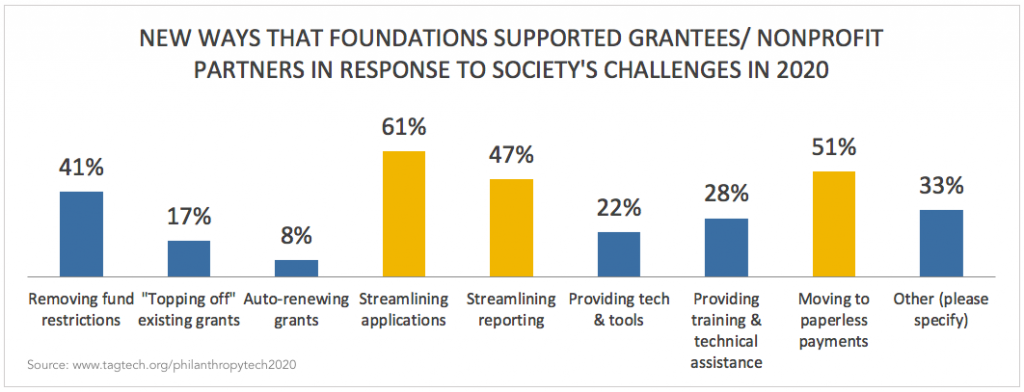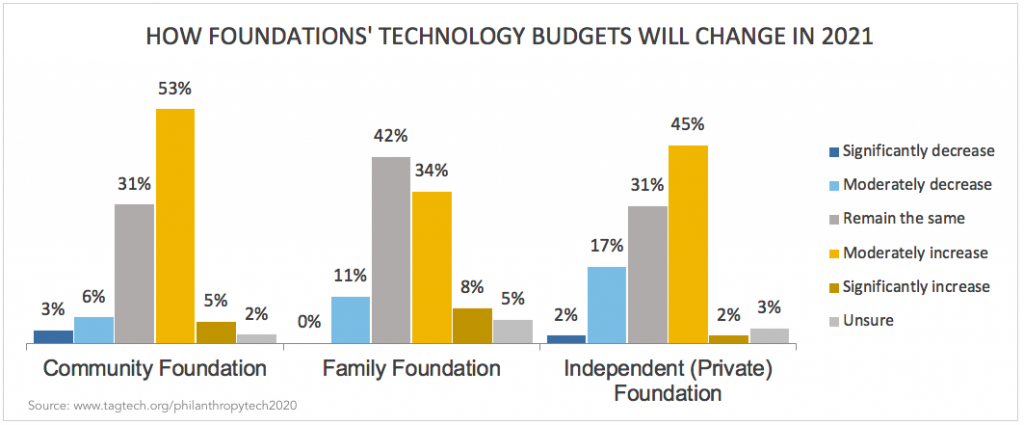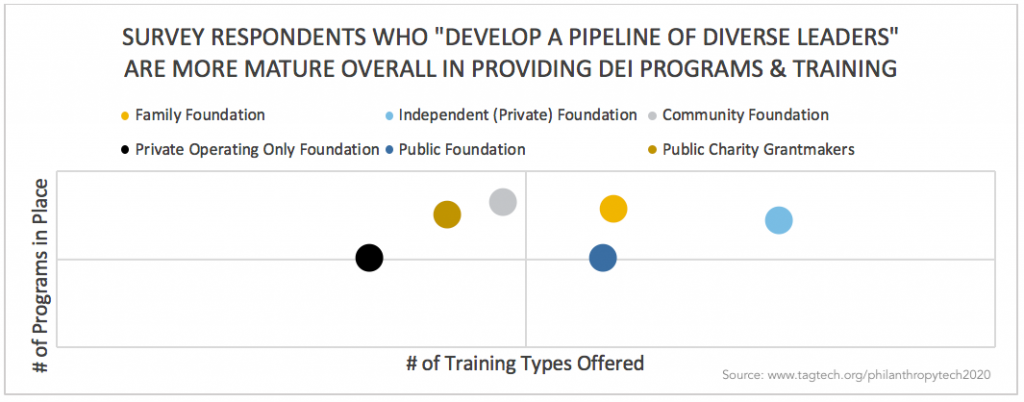Reflections from the 2020 State of Philanthropy Tech Survey by TAG
It's often said that philanthropy moves like a bear in hibernation, slowly and only when forced to do so. And yet, I am convinced that 2021 will be anything but torpid for the role of technology in philanthropy and the social sector more broadly. The social crises of 2020 have prompted extraordinary reflection for most organizations. I'm already seeing important behavioral changes in the way grantmakers leverage technology both internally and externally with nonprofit partners. A recent survey by the Technology Association of Grantmakers, which I serve as Executive Director, provides data on these changes and sets a course for 2021.
Every two years, philanthropy pauses to reflect on the state of technology in the biennial "State of Philanthropy Tech" survey by the Technology Association of Grantmakers (TAG). This year's survey builds on past surveys, which explored IT tools; management; security; diversity, equity, and inclusion (DEI); integration between IT and program teams; and more. TAG has also added questions about COVID-19 and how emerging societal challenges affect how foundations support grantees and nonprofit partners. 233 foundations in North America and beyond responded to this year's survey, and their experiences provide insight into the future of philanthropy tech.
Three key trends emerge from this year's survey that set a course for 2021. In the coming year, foundations and their nonprofit partners will see the following themes loom large:
- The "Grantee Experience" Matters
- Tech Is Foundational To Modern Philanthropy
- Equity Is A Priority For Tech Teams Too
The "Grantee Experience" Matters
The social sector's rapid adaptation to the constraints of COVID-19 as well as the increased need for services form the basis of an overdue recognition: The grantee experience of systems, tools, and tech required by a funder enhances or alternately detracts from that nonprofit's ability to deliver on their mission. Put more simply, the grantee experience of philanthropy can make or break their mission.
In 2020, this "make or break" reality became a clarion call for philanthropy to streamline and support the grantee experience in 2020. As shown in the chart below, 61% of responding foundations report streamlining the grant application process in response to COVID-19, while 47% report streamlining the reporting process this year. Recognizing and rapidly reducing the burden on grantees of onerous application and reporting is a heartening change in philanthropy. However, some funders went even further. According to our survey, 28% of responding foundations in 2020 provided training and technical assistance directly to grantees, while 22% report providing tools and tech.
[caption id="attachment_154111" align="alignnone" width="640"]
 (Click image to enlarge) The top three responses are 1) 61% streamlining applications, 2) 51% moving to paperless payments, and 3) 47% streamlining reporting.[/caption]
(Click image to enlarge) The top three responses are 1) 61% streamlining applications, 2) 51% moving to paperless payments, and 3) 47% streamlining reporting.[/caption]Such a sudden focus on the grantee experience mirrors the increasing centrality of the "customer experience" in the private sector, where the customer journey, viewpoint, and experiences are managed with an eye toward satisfaction and efficiency. Will 2021 see the rise of a "Customer [or Grantee] Experience Officer" in philanthropy? The changes seen in 2020 portend an increasing significance of the grantee experience in philanthropy operations.
Tech Is Foundational To Modern Philanthropy
Like many nonprofits, grantmakers historically have underfunded technology. According to a 2017 study of NetHope members[1], the average IT spending ratio at global nonprofits is just 2% and ranges from 0.08% to 4.89%. In contrast, Harvey Nash / KPMG reported in 2019 that the percentage of private-sector organizations' revenue spent on IT varies between 4.8% (manufacturing/automotive, retail/consumer goods) and 22.5% (technology)[2]. In summary: Private sector spending on technology, regardless of industry, is likely to be at least four times that of the social sector.
2020 laid bare existing gaps in infrastructure funding as philanthropy (and many of their nonprofit partners) transitioned quickly to remote work. The mass closure of offices helped crystalize conversations that organizations were having about how they work and the technology they need to do it. One survey respondent said, "The pandemic brought [our organization] to more holistically integrate technology into the mission of the foundation."
As a result, foundations are now investing for more robust operations in the future. According to the State of Philanthropy Tech survey, 51% of respondents expect their IT budget to increase in 2021. Only 12% indicated that they would moderately or significantly decrease their technology budget.
Community foundations, in particular, are choosing to invest more heavily in IT. More than half (58%) said they expect to moderately or significantly increase their technology budgets.
[caption id="attachment_154110" align="alignnone" width="640"]
 (Click image to enlarge) Moderately increase: Community foundation: 53%. Family foundation: 34%. Independent (private) foundation: 45%. Remain the same: Community foundation: 31%. Family foundation: 42%. Independent (private) foundation: 31%.[/caption]
(Click image to enlarge) Moderately increase: Community foundation: 53%. Family foundation: 34%. Independent (private) foundation: 45%. Remain the same: Community foundation: 31%. Family foundation: 42%. Independent (private) foundation: 31%.[/caption]While private sector investment in technology continues to outpace the social sector, the foundation budgets planned for 2021 manifest an awareness that, in the digital age, investing in technology infrastructure is an investment in social impact. You can expect this awareness to further stimulate growth in nonprofit tech investment as well.
Equity Is A Priority For Tech Teams Too
With increasing focus and funding, philanthropy continues to prioritize the work of racial equity; however, IT departments are often left behind. This gap is longstanding. In 2019, I made the case in Inside Philanthropy with Satonya Fair, now CEO of PEAK Grantmaking, that the consequences of biases in technology systems unwittingly undermine the work of philanthropy:
"Operations staff shape not only the infrastructure for every interaction with a foundation but also the experience or the "how" of those interactions. Hence, when it comes to achieving the best outcomes in communities, operations and programming staff must have an equally strong awareness of DEI principles and best practices. Not striving toward this goal would be a missed opportunity for philanthropic leaders, one that could undermine progress and even create new barriers to success." [3]
As shown in TAG's 2020 survey, this gap continues. Internal training or programs are often provided to "front-facing" program staff, excluding technology staff and vendors. In fact, 40% of survey respondents in 2020 said "none of the above" when asked which diversity, equity, and inclusion (DEI) programs their organizations have in place for technology departments. When offered to IT teams, such programs often focus on diversity in hiring only, excluding professional development and leadership cultivation.
[caption id="attachment_154113" align="alignnone" width="640"]
 (Click image to enlarge) 37% Demonstrate fairness in performance and compensation decisions. 33% Recruit diverse candidates. 12% Develop a pipeline of diverse leaders. 11% Provide targeted development opportunities for diverse employees. 51% say they don't have any of these or don't know (not knowing is the same as not having.)[/caption]
(Click image to enlarge) 37% Demonstrate fairness in performance and compensation decisions. 33% Recruit diverse candidates. 12% Develop a pipeline of diverse leaders. 11% Provide targeted development opportunities for diverse employees. 51% say they don't have any of these or don't know (not knowing is the same as not having.)[/caption]There's room for optimism: The 2020 survey results reflect an 11% improvement over 2018 when 51% of respondents indicated that technology teams had no DEI programs in place. When coupled with this year's increased focus on social justice and the role of technology in exacerbating bias, this momentum serves to forecast a watershed moment.
2021 promises to be the year when foundations address the gap in equity programs and training for operations staff such as IT. Already among the TAG membership, I'm seeing organizations commit to providing DEI training not only for IT staff but contractors and vendors as well. I'm seeing organizations recognize that they need to move beyond a "check the box" approach to hiring diverse staff and also provide development and leadership cultivation. This deeper understanding of equity and inclusion offers a maturity model worth emulating. As shown below, organizations that recognize developing diverse leadership is key to culture change tend to offer more programs and training for IT teams than their peers.
[caption id="attachment_154112" align="alignnone" width="640"]
 (Click image to enlarge) The data shows an emerging maturity model for the work of DEI in foundations.[/caption]
(Click image to enlarge) The data shows an emerging maturity model for the work of DEI in foundations.[/caption]Such mature organizations are worth examining further. Have these organizations responded to internal forces of change, or have the events of 2020 stimulated a new commitment to equity? What lessons have they learned? What strategies have been most effective? Leveraging the momentum of 2020 will require lamp-posts to inspire and guide. I look forward to elevating these success stories further in 2021 as we evolve together toward a just and sustainable future.
Learn more about the 2020 State of Philanthropy Tech survey and download the summary of findings.
[1] The 2017 NetHope study was conducted internally and shared only with NetHope members.
[2] https://www.hnkpmgciosurvey.com/press-release.php
[3] https://www.insidephilanthropy.com/home/2019/8/26/as-foundations-reimagine-themselves-they-should-give-attention-to-dei-in-operations
Jean Westrick
She/Her
Executive Director, Technology Association of Grantmakers
Jean Westrick is a strategic, creative leader with two decades of experience in philanthropy, including technology implementation, program strategy and execution, and foundation operations. Prior to being named the next Executive Director of the Technology Association of Grantmakers, Ms. Westrick was the Director of IT Strategy and Communications at The Chicago Community Trust where she led change management efforts for the foundation’s digital transformation initiative. Also, while at the Trust, Ms. Westrick directed On the Table, an award-winning engagement model designed to inspire resident action, replicated in 30 cities nationwide.
A longtime advocate for equity in STEM education, technology access and science literacy, Ms. Westrick holds a Bachelor of Arts from Michigan State University and a Master of Science from DePaul University.